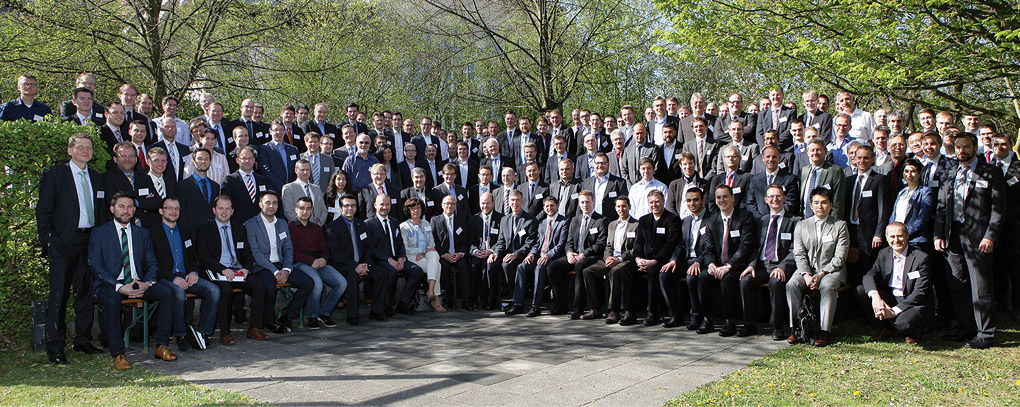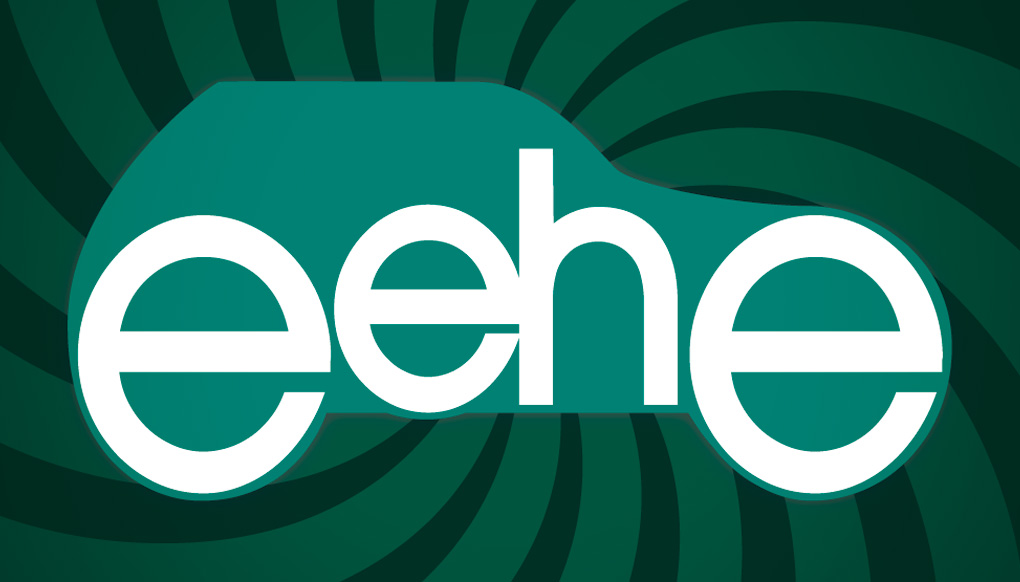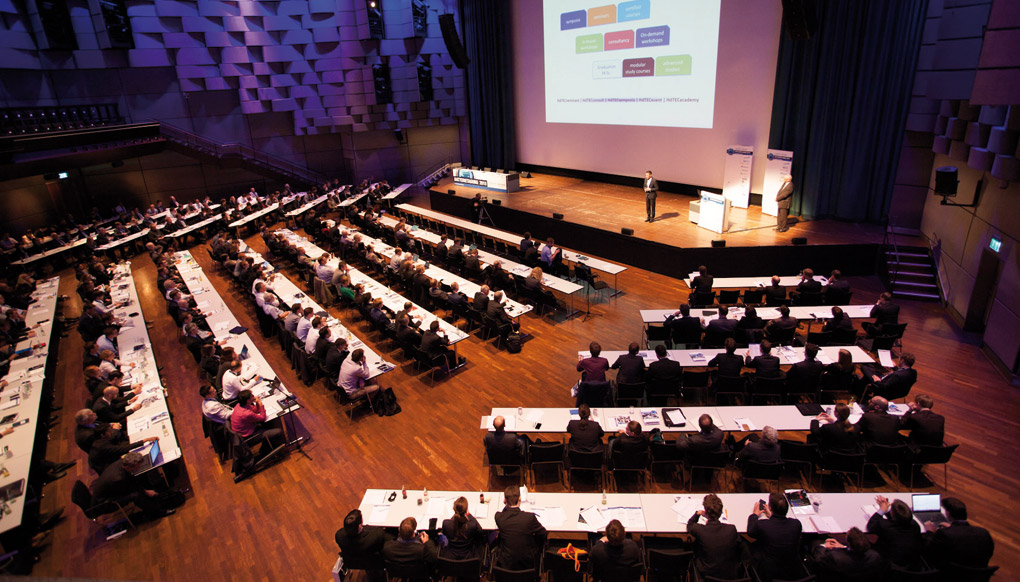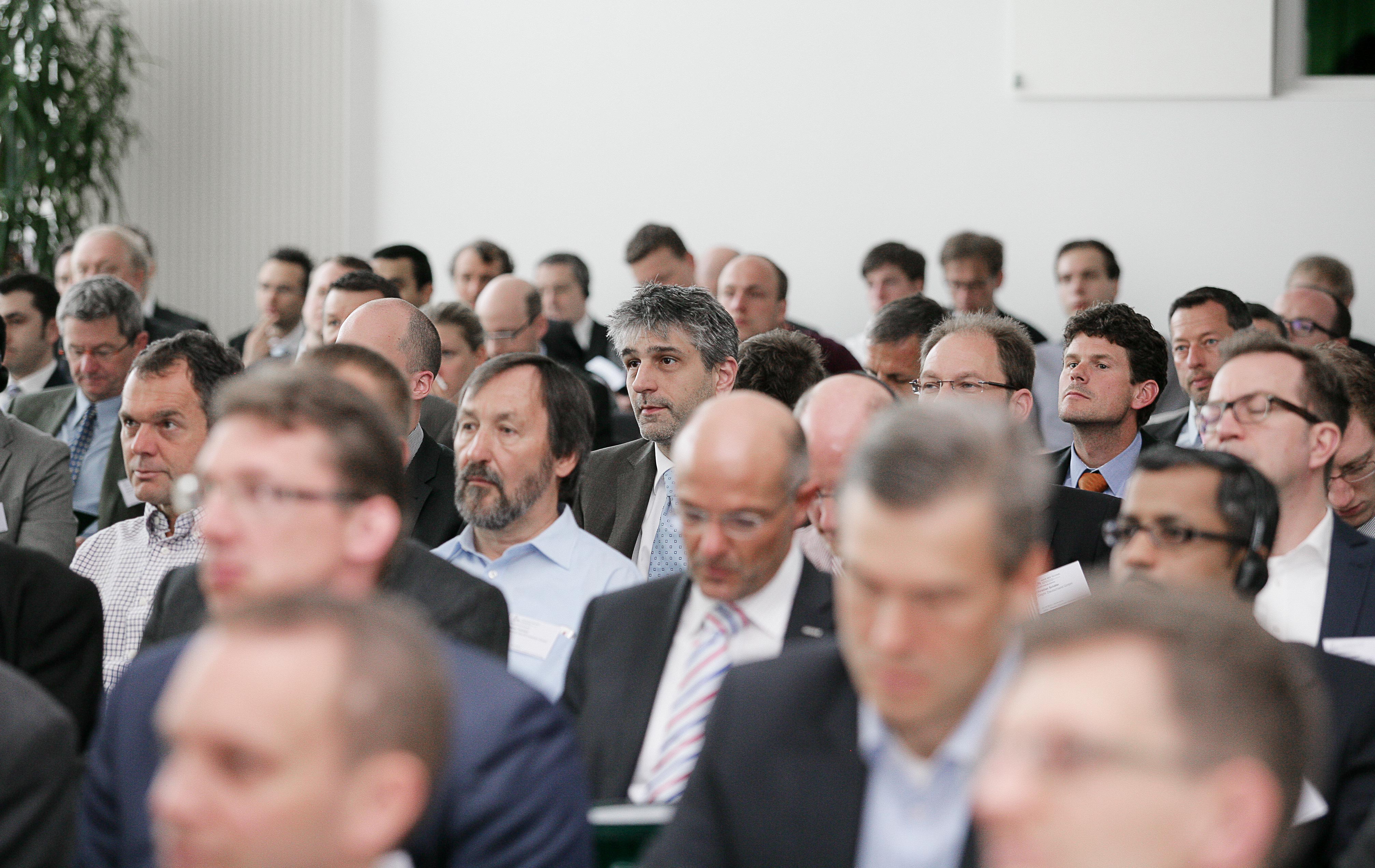EEHE – Electric & Electronic Systems in Hybrid and Electric Vehicles and Electrical Energy Management – International Conference in Wiesloch (near Heidelberg) on 8-9 June 2016 – Simultaneous Translation provided!
Ever stricter emissions requirements in the automotive sector are an imperative for OEMs to reassess energy saving potentials and to search for smart solutions. Besides weight reduction, powertrain electrification plays a significant role in meeting objectives. The focus is still on 48V on-board power supply and energy management. Strictly speaking, every modern passenger car in Germany can already today be considered an electric vehicle because there are hundreds of electric loads and electronic control units in all of them. In addition, a wide variety of electric and hybrid vehicles with an electric system as their main source of propulsion is available on the market.
OEMs, suppliers and research institutes, now as before, are active in furthering new mobility concepts which make cars fit for the future. The components required for the powertrains to be used in 2020 are already being developed today. Numerous OEMs and suppliers are currently finding their positions in this exciting market. To get into pole position they require expertise and knowledge in areas such as power electronics, powertrains, electric motors, battery engineering and energy efficiency. Software specialists and their expertise are needed to bring together geo-data and driving profiles so as to tackle the issues from yet another angle.
With EEHE, the outstanding conference on electric and electronic systems in hybrid and electric vehicles and electrical energy management, Haus der Technik provides ample opportunity for networking among developers, users and scientists. Important players of the industry will come together at this international conference to explore ideas and exchange knowledge. From more than seventy submissions a particularly attractive programme has been put together. Conference participants appreciate the space for exchanging ideas and meeting people.
Away from the lectures there will be an exhibition. The conference participants will see electric and hybrid vehicles as well as test vehicles displayed by prestigious OEMs and will also be able to drive some of them.
Simultaneous translation will be provided.
Please get in touch with Haus der Technik for further information and details of the conference programme.
Tel: 0049-201-1803-249, email: information@hdt-essen.de, internet: www.eehe.de
On Haus der Technik
Haus der Technik HdT serves as a platform for the transfer of knowledge and continuous professional development at the highest level. With more than 80 years of experience as an independent institute providing continuing education for specialists and managerial staff, HdT offers technical seminars, symposiums and in-house workshops to promote innovation and to provide for the transfer of know-how and expertise. The original idea of the HdT founding fathers is still alive: we wish to support companies to be successful in a competitive environment by offering services to knowledge workers. HdT brings together academia and industry. HdT partners with RWTH Aachen University and the Universities of Bonn, Braunschweig, Duisburg-Essen and Münster and at the same time maintains close contacts with companies and research institutes which makes HdT a forum for the exchange of knowledge and experience.
Contact and further information:
Bernd Hömberg
Haus der Technik e.V.
Hollestraße 1
45127 Essen
Tel.: +49 (0)201/1803-249
Fax: +49 (0)201/1803-269
E-Mail: b.hoemberg@hdt-essen.de
8. Internationale Fachtagung
Kraftwerk Batterie 2016
am 26. – 27.04.2016 in Münster
www.battery-power.eu
5 Fragen an Jens Leibold, Entwicklungsingenieur Synthese/Konzepte im Geschäftsbereich Powertrain Entwicklung der IAV GmbH
Die Tagung „Elektrische Traktions- und Hilfsantriebe für Hybrid- und Elektrofahrzeuge“ vom 17.-18.11.2015 in Würzburg findet in zweijährlichem Rhythmus statt und ist eine hervorragende Expertenplattform rund um die wachsende Elektifizierung in Fahrzeugen.
Jens Leibold, Entwicklungsingenieur Synthese/Konzepte im Geschäftsbereich Powertrain Entwicklung der IAV GmbH, beantwortet 5 Fragen zum Thema:
- Welche zusätzlichen Komponenten werden in Zukunft im Automobil elektrifiziert?
Für rein elektrische Fahrzeuge natürlich alle bisher mechanischen angetriebenen Nebenaggregate. Bei Hybrid-, speziell bei Plug-In-Hybrid-Fahrzeugen sind ähnliche Szenarien denkbar, in jedem Fall Lenkhilfemechanismen und Bremskraftverstärker. Zusätzlich Kältemittelverdichter und alle Mediempumpen (Wasser-/Ölpumpen). - Welche Rolle spielt das 48 V Bordnetz bei der Elektrifizierung im KFZ?
Ein ganz Bedeutende! Für kleine und kostengünstige Elektrifizierungen werden 48 V-Systeme den Markt der Mild-Hybridisierung bis max. 13 … 15 kW weiter ankurbeln. - Welche besonderen Anforderungen gelten für elektrische Maschinen im Fahrzeug?
Im Vergleich zu den Maschinen im industriellen Sektor, haben automotive-taugliche Motoren strengeren Anforderungen in Bezug auf Schwingungen. Auch die Lastprofile und Anforderungen an die Drehmomentdichte sind oft höher. - Welchen Einfluss hat die Überlastfähigkeit eines elektrischen Traktionsmotors auf seine thermische Auslegung?
Grundsätzlich ist zwischen Dauer- und Kurzzeitleistung zu unterscheiden. Für die Dauerleistung können neuartige Kühlkonzepte helfen die Überlastfähigkeit zu verbessern. Eine direkte Ölkühlung hat z. B. eine deutlich bessere Fähigkeit die Wärmeleistung abzuführen, als eine konventionelle Wassermantelkühlung bei der ein Wärmestrom erst aufwendig über mehrere Übergangswiderstände transportiert werden muss. - Kann die elektromagnetische Geräusch- und Schwingungsanregung von Asynchron-Traktionsmaschinen durch eine optimale Auslegung minimiert werden?
Ja, und zwar deutlich. Hierzu wird zur Tagung auch vorgetragen.
Mehr Informationen zur Tagung finden Sie unter www.hdt.de
Am 05. – 06.11.2015 in München über Grundlagen, Untersuchungsmethoden und Sicherheitstests insbesondere von Lithium-Ionen-Batterien auf Zell-, Modul- und Packbasis
Die Batteriesicherheit erlangt steigende Bedeutung angesichts neuer Batterietechnologien höchster Energiedichten, der sich verbreitenden Nutzung von automobilen Hochvolt-Lithiumionen-Speichern und der Einführung von stationären Energiespeichern. Unfallserien und Rückrufe wie 2006 bei Laptop-Batterien hätten heute immense negative Auswirkungen auf die Akzeptanz der Elektromobilität und der stationären Energiespeicherung. Das Seminar wird Grundlagen, Untersuchungsmethoden und Tests zur Beurteilung der Sicherheit von Materialien, Zellen, Modulen und Packs vorstellen.
Die Themen:
- Die Lithium-Ionen-Batterie – Einfluss von Chemie und Materialien auf die Zellsicherheit
- Methoden zur Beurteilung der Sicherheit auf Materialebene
- Versagensmechanismen von Zellen und Designs für verbesserte Zellsicherheit
- HV-Sicherheit, gesetzl. Vorgaben zur Arbeitssicherheit
- Vorstellung von vergleichenden Sicherheitstests an untersch. Zellchemien
- Lagerung und Transport von Batterien, Entsorgungskonzepte
- Aktuelle Normen für Sicherheitstests und Homologationsprüfungen
- Zertifizierungsmöglichkeiten des Sicherheitsverhaltens von Stationär- und Pedelecbatterien
Mehr Informationen und Anmeldung

Rund 200 Teilnehmer, 50 Referenten, eine attraktive Ausstellung, zahlreiche Elektro-, Hybrid- und Testfahrzeuge sowie unzählige Gespräche, Diskussionen interessante Kontakte sind die Kurzfassung einer erfolgreichen Tagung.
Ottmar Sirch and Carsten Hoff together with von 112 co-authors. Year of publication 2015, 555 pages, 467 pictures, 28 charts (HdT, 138) ISBN: 978-3-8169-3311-3
Der Fortschritt der Elektromobilität durch die erfolgreichen Markteinführungen hochelektrifizierte Fahrzeuge und der ständig steigende Druck zur Verringerung der weltweiten CO2-Emissionen beschäftigen weiterhin die gesamte Automobil- und Zulieferindustrie und die darauf ausgerichtete Forschung und Wissenschaft. Die Konzepte für Elektrofahrzeuge, Plug-In-Hybride, Vollhybride bis hin zu Mikrohybriden und Fahrzeugen mit Start-Stopp-Funktionalitäten nehmen einerseits immer konkretere Formen an, werden aber andererseits hinsichtlich Kosten und Effizienz mit immer höheren Anforderungen konfrontiert. Die unterschiedlichen Hybridfahrzeugkonzepte ebnen den Weg für reine Elektrofahrzeuge. Die Lösungen dazu entstehen bereits heute in den Köpfen der Forscher und Entwickler. Für die neuen Gesamtkonzepte mit elektrifizierten Antrieben und Nebenaggregaten sowie E/E-Architekturen müssen technisch anspruchsvolle und betriebswirtschaftlich zielführende Konzepte entwickelt und erprobt werden.
In diesem Themenband stellen Experten aus der Forschung und der Entwicklung die neuesten Trends dar.
Inhalt:
- Hybrid and Electric Vehicles
- E/E-Architectures and Electrical Energy Management
- Market Development and Trends
- Power Electronics and DC/DC-Converters
- High Voltage and Low Voltage Energy Storage
- Charging Systems
- Model-Based Development Methods
- Components and Sensoring
Die Interessenten:
Die Beiträge sind interessant für alle Experten und Führungskräfte in der Entwicklung Elektrik/Elektronik bei Automobilherstellern, Zulieferern und Subzulieferern, für angrenzende Fachbereiche Qualität, Einkauf und Produktion, für Hochschulen und Forschungsinstitute im Bereich Automobiltechnik, für die Elektronikindustrie mit Aufbau- und Verbindungstechnologien und Bauelementen, für Normierungsgremien, Behörden und der Automobilindustrie nahestehende Fachverbände.
Die Autoren:
Ein hochkarätiges Gremium aus Hochschulprofessoren und aus Führungskräften und Fachexperten der Entwicklungsressorts von Automobilherstellern, Systemlieferanten und Halbleiterherstellern zeichnet sich für die Auswahl der Beiträge verantwortlich.
Die Autoren der einzelnen Fachbeiträge sind Experten in den jeweiligen Fachgebieten und Disziplinen und kommen aus den entsprechenden Unternehmen und Institutionen. Die gesamtverantwortlichen Autoren sind bei Automobilherstellern und -zulieferern in verantwortlichen Funktionen in der Entwicklung im Bereich Energiebordnetz, Elektrifizierung und Energiemanagement tätig und verfügen über langjährige Erfahrung aus verschiedenen Projekten für Hybrid- und Elektrofahrzeuge sowie für Motor-Start-Stopp und Energiemanagement-Systeme.
mehr Informationen und Bestellmöglichkeit beim Expert Verlag
Ab sofort können Sie hier online die Kurzfassung Ihres Beitrages für die Fachtagung EEHE 2015 (Elektrik/Elektronik in Hybrid- und Elektrofahrzeugen und elektrischen Energiemanagement) einreichen. Der Call for Papers läuft noch bis zum 17.10.2014.
Die aktuellen Themenschwerpunkte der Tagung sind:
- Components, systems and architectures and design tools for Micro up to Full Hybrid, Plug-in-Hybrid and Electric Vehicles
- Electrified powertrain systems, semiconductors for Hybrid and Electric Vehicle applications
- 12/48V power supply system architectures and 48V components
- Multiple voltage power supply (12V/24V/48V/HV)
- Electrical energy management
- Battery management & low voltage accumulators
- Electric charging
- Power electronics
- Special applications for heavy duty vehicles
- Development tools and methods
- Power supply systems for highly automated or autonomous drive
Bitte nutzen Sie für die Einreichung Ihres Beitrages unser Online-Formular.
Ottmar Sirch und Carsten Hoff with co-operation of 106 co-authors 2014, 502 pages., 376 pictures, 34 charts, ISBN: 978-3-8169-3264-2
Vorwort
Hybrid, Plug-In Hybrid and Electric Vehicles are entering the worldwide automotive market and the expectations are that by the middle of this decade there will be a wide range of established OEMs as well as newcomers offering these kinds of vehicles. Forecasts from several market research institutes project a significant increase of annual growth in volumes and revenues. According to ZSW (Zentrum für Sonnenenergie- und Wasserstoff-Forschung Baden- Württemberg), the number of registered electric vehicles worldwide has increased at an annual rate of more than 100% over the last three years. At the beginning of 2012, nearly 100,000 of the cars were on the roads worldwide. This sum rose a year later to a total of 200,000, and then again to 405,000 units earlier this year. ZSW projects that, if growth increases at the same rate, there will be more than 1 million electric vehicles on the road by the beginning of 2016. This tally does not include motorcycles, trucks, buses and the now more than 6 million conventional full-hybrid vehicles. The US, Japan and China are leading the market, according to the analysis, followed by France, Holland, Norway and Germany. Japanese and US automotive groups are the leading providers, assisted by strong market incentive programs in their countries. Nissan is the top-seller, followed by GM/Opel and Toyota; Tesla is accelerating rapidly. The batteries for the xEVs come mainly from Japan and South Korea, ZSW noted [1].
After a period of several years which was dominated by Toyota´s hybrids a lot of major players launched their xEVs onto the market and announced strategic approaches to cover a wide spectrum of electric vehicles and to meet the requirements for the next generation products in terms of technical characteristics, costs, production and aftersales. Experts for all product areas – e.g. motors, power electronics and energy storages – have been employed during the last years either in the automotive industry as well as other related branches and are working intensively together to provide appropriate concepts. Analyzing different OEMs we see different approaches for the challenging xEV market: The Volkswagen Group’s MQB modular platform is one of the four main modular toolkits (modulare Baukästen) of the Group: the MQB (transverse), the MLB (longitudinal), the MSB (standard drive), and the NSF (new small family). The platforms standardize many vehicle component parameters across brands and vehicle classes, while at the same time offering access to new technologies, such as alternative drive systems. The new Mark 7 Golf, which is MQB-based, offers gasoline, diesel, natural gas, plug-in hybrid (the GTE), and battery-electric (the e-Golf) versions, all of which can be manufactured bumper-to-bumper on the same assembly line. The MQB spans the A0 to C segment [2].
The Ford Motor Company, in conjunction with GE, will supply electric vehicle charging stations at Ford facilities nationwide, beginning with facilities in and around its headquarters in Detroit. Ford will begin installing the GE WattStation Level 2 charging stations across its North American campuses, developing a workplace charging network at nearly every Ford facility in the United States and Canada using the new charging network, Ford employees commuting to their jobs from up to 21 miles away in plug-in hybrid vehicles – Fusion Energi and C-MAX Energi – may be able to drive entirely on electric power to and from work. Fusion Energi and C-Max Energi have EPA-estimated MPG ratings of 44 mpg US city, 41 highway and 43 combined and have an EPA-estimated range of 21 miles (34 km) electric. Drivers of the electric-only Focus Electric, which has an EPA-estimated range of 76 miles (122 km) on a full charge, will have even more gas-free commuting potential. The Ford charging service will be free to employees for the first four hours of charging each day. By offering free charging, Ford is trying to encourage charging station sharing, enabling twice as many employees to charge at work for free. Ford is also asking employees to use the MyFord Mobile smartphone app to collect driving and charging information to help the company understand driving patterns and potentially influence future product design.
Ford estimates it will cost about 50 cents to fully charge each vehicle. Ford’s WattStation charging station units will be connected together. As a result, the company will be able to gather comprehensive information on electrified vehicle use, such as the number of hours vehicles are charging and the amount of carbon dioxide reduced. It can then use actual station data to plan for additional station installations. Ford plans to install electric vehicle charging stations at more than 60 of its offices, product development campuses and manufacturing facilities. The installation will begin at Ford’s southeast Michigan facilities and roll out across other facilities throughout 2014.
Beside these activities the efforts to improve fuel consumption and CO2 emissions of conventional vehicles with internal combustion engines are an ongoing process. New approaches for energy management, highly sophisticated operating strategies and new technologies are being researched and developed and will be applied soon. These technologies are combined to new powerful systems which are capable of fulfilling the CO2 targets as well as the requirements for new features. Alternatively to today´s established 12 Volt, 48 Volt is establishing itself as a new vehicle power supply voltage, which increases the capability of the conventional vehicles with internal combustion engines in terms of electric power for new features, recuperation, fuel consumption and CO2 emissions to improve its position in the competition with xEVs. The market potential for a 48 V power supply has been evaluated by a number of parties including institutes, OEMs and suppliers. The results show significantly rising volumes in the second half of this decade.
Forecasts in analysts’ figures show a significant market share for 48 Volt beyond 2020. Additionally, for 2025 market research predicts that more than 30% of all vehicles will have an electrified powertrain.
The book in hand was created for the 3rd conference “Electric & Electronic Systems in Hybrid and Electric Vehicles and Electrical Energy Management” organized by Haus der Technik e.V. Essen May 6th and 7th, 2014, in Bamberg. Subjects and articles about the overall system of electrics/electronics of hybrid and electric vehicles and concepts of electrical energy management will be presented and discussed in detail. Solutions for hybrid, plug-in hybrid and electric vehicles and E/E architectures, charging systems, power electronics, and low voltage accumulators will be covered.
We want to thank all the authors and speakers whose interesting technical contributions support the edition of this book. Furthermore, we thank Mr. Bernd Hömberg and his staff from Haus der Technik e.V. in Essen for planning and organizing the event, Mrs. Anita Koranyi and Mr. Matthias Wippler from expert-Verlag in Renningen for publishing the book and Mrs. Dr. Vera Lauer, Mr. Dirk Balzer, Mr. Prof. Dr. Ludwig Brabetz, Mr. Prof. Dr. Stephan Frei, Mr. Friedrich Graf, Mr. Prof. Dr. Hans-Georg Herzog, Mr. Dr. Jan Lichtermann, Mr. Dr. Marc Nalbach, Mr. Dr. Dieter Polenov, Mr. Dr. Hartmut Pröbstle, Mr. Dr. Tomas Reiter, Mr. Prof. Dr. Dirk-Uwe Sauer, Mr. Peter Schmitz and Mr. Richard Schöttle for their support and engagement in the program committee.
Bamberg, May 2014
Ottmar Sirch Dr. Carsten Hoff
Ottmar Sirch und Carsten Hoff: „Elektrik/Elektronik in Hybrid- und Elektrofahrzeugen IV“ unter Mitarbeit von 145 Ko-Autoren 2013, 581 S., 456 Abb., 44 Tab., ISBN-13: 978-3-8169-3213-0
Die Elektromobilität und der ständig steigende Druck zur Verringerung der weltweiten CO2-Emissionen beschäftigen weiterhin die gesamte Automobil- und Zulieferindustrie und die darauf ausgerichtete Forschung und Wissenschaft. Die Konzepte für Elektrofahrzeuge, Plug-In-Hybride, Vollhybride bis hin zu Mikrohybriden und Fahrzeugen mit Start-Stopp-Funktionalitäten nehmen einerseits immer konkretere Formen an, werden aber andererseits hinsichtlich Kosten und Effizienz mit immer höheren Anforderungen konfrontiert. Die unterschiedlichen Hybridfahrzeugkonzepte ebnen den Weg für reine Elektrofahrzeuge. Die Lösungen dazu entstehen bereits heute in den Köpfen der Forscher und Entwickler. Für die neuen Antriebe und die notwendigen Nebenaggregate müssen technisch anspruchsvolle und betriebswirtschaftlich zielführende Konzepte entwickelt und erprobt werden.
In diesem Themenband stellen Experten aus der Forschung und der Entwicklung die neuesten Trends dar.
Inhalt:
- Electric Vehicles and E-Mobility
- 48 Volt System Integration and Components
- Power Electronics, Components and Technologies
- HV Storage and Charging Systems
- Electrical Energy Management and Model-Based System Optimization
- 12 Volt Energy Storage and Battery Modelin
Die Interessenten:
Die Beiträge sind wichtig für Führungskräfte und Experten in der Entwicklung Elektrik/Elektronik der Automobilindustrie, bei Zulieferern und Subzulieferern, für die Fachbereiche Qualität, Einkauf und Produktion, für Hochschulen und Forschungsinstitute im Bereich Automobiltechnik, für die Elektronikindustrie mit Aufbau- und Verbindungstechnologien und Bauelementen, für Normierungsgremien, Behörden und der Automobilindustrie nahestehende Fachverbände.
Die Autoren:
Ein hochkarätiges Gremium aus Hochschulprofessoren und aus Führungskräften und Fachexperten der Entwicklungsressorts von Automobilherstellern, Systemlieferanten und Halbleiterherstellern zeichnet sich für die Auswahl der Beiträge verantwortlich
200 Experten diskutierten in dieser Woche über die Umsetzung alternativer Antriebskonzepte im KFZ. Mit der Vorstellung des Porsche 918 Spyder wurde der Rahmen nach oben hin abgesteckt. Die führenden OEMs und Zulieferer beschäftigen sich anschließend mit den Detaillösungen in den Bereichen: Elektrik/Elektronik für Hybrid-, Plug-In-Hybrid- und Elektrofahrzeuge, elektrisches Laden, elektrisches Energiemanagement, Leistungselektronik, Niedervolt-Speicher und Batteriemanagement für elektrische Energiespeicher, Marktentwicklung, hochautomatisiertes Fahren und modellbasierte Entwicklung. Das internationale Interesse an der Tagung ist weiter gestiegen. Bis zum Schluss wurde in den beiden Parallelsitzungen intensiv diskutiert.
Herr Soczka-Guth von Daimler zeigte mit seinem Vortrag, dass die Zellchemie in der Batterie kein Hexenwerk ist. Frau Rothgang vom ISEA in Aachen präsentierte neueste Ergebnisse zur Lebensdauerstreuung. Viele weitere Fragestellungen beschäftigten die Fachleute: Was kann noch getan werden, um den Verbrauch der Fahrzeuge weiter zu senken? Wann kommt das 48V Bordnetz? In den Vorträgen wurde um jedes Gramm CO2 gefeilscht. Der neue europäische Fahrzyklus NEFZ ist dabei das Maß aller Dinge. Gut besucht waren auch die Sitzungen zur Leistungselektronik sowie die Anforderungen an das Bordnetz im Zusammenhang mit dem Thema „Automatisiertes Fahren“. Die Ausstellung war in diesem Jahr zum ersten Mal ausgebucht.
Das Thema der Hybridisierung bleibt spannend und das große Interesse und die nicht endenden Diskussionen lassen für die nächste Tagung am 22.-23.4.2015 in Bad Boll zahlreiche Einreichungen erwarten.





